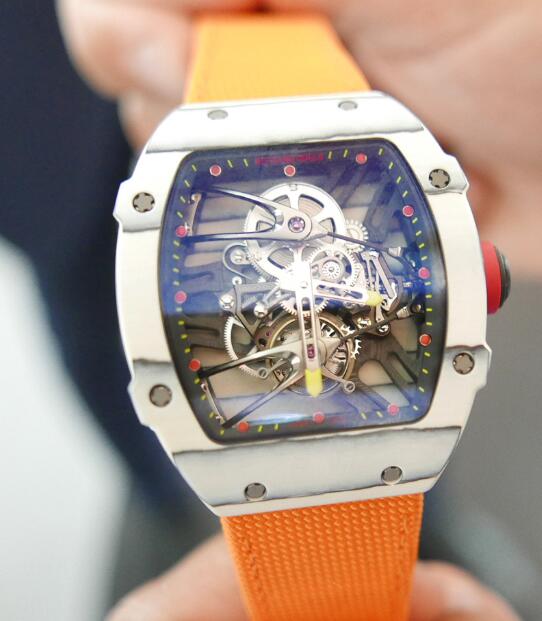
The Master of Modern Watchmaking – the namesake brand embodies Richard Mille’s vision for 21st century watchmaking: an avant-garde luxury watch that symbolises a subversion of the past.
A Brief History of Richard Mille
Born in Draguignan, France in 1951, Richard Mille luxury studied marketing and entered watchmaking almost by accident. Richard Mille was the export manager of the French watchmaking company Finhor before being promoted to director of numerous watchmaking brands following the Matra Group’s acquisition of Finhor.
In 1990, he became CEO of Mauboussin’s watchmaking department and headed the jewelry department. He was deeply involved in the design process, and his insight into design combined with a love of mechanics gave rise to the idea of the Richard Mille watch as we know it today.
“I want to make the watch of my dreams, I can’t find it anywhere” – Richard Miller
With technological innovation, art and a culture of fine watchmaking, Richard Mille became a dominant player in modern watchmaking, regarded by many as the ultimate expression of wealth.
From the very beginning, Richard Mille’s plan was to create a Formula 1 car in the world of watchmaking, with no regard for production costs, focusing on the use of modern production techniques and high-tech materials for maximum performance. Extremely avant-garde and technically powerful, Richard Mille transforms advanced technology and futuristic materials into pure design and extraordinary creativity while fusing traditional watchmaking craftsmanship.
Marking a break in watchmaking history, Richard Mille revolutionized the world of luxury watches, replicating the way automotive engineers build Formula 1 cars, taking design, material use, components and function into account, and delivering them with flawless finish. Execution.
In 2001, the watch industry saw the first Richard Mille RM 001 at Baselworld in 2001, with the support of renowned Swiss movement manufacturers including Audemars Piguet Renaud et Papi. A limited release, the RM 001 has firmly established itself as one of the most iconic and unique timepieces in the world.
In 2007, Richard Mille became a member of the Haute Horlogerie Foundation and has since received the most coveted accolade in the horological world, the Golden Eagle.
Richard Mille himself is an example of the lifestyle his eponymous brand has influenced, regularly appearing in sports cars and rowing races, travelling the world in private jets and hanging out with A-listers.
To date, Richard Mille has worked with many athletes and celebrities, involving them in the design process to create extraordinary timepieces that can perform under extreme conditions and critical stress tests. Tourbillon escapements in traditional watchmaking are notoriously fragile, and Richard Mille proved this theory wrong with his RM036 “G-Sensor Tourbillon”, which can withstand the damage to most tourbillon-based movements various forces. Richard Mille watches are known to be resistant to shocks up to 5000G and durable enough to be worn in extreme sports like tennis, golf, track and field and skiing. Richard Mille redefines the traditional view of high-end watch collecting and encourages his elite clients to wear Richard Mille watches for all occasions rather than keeping them in a safe.
Facts about Richard Mille
The size and shape of any Richard Mille watch is instantly recognizable, even from a distance. Often composed of three layers, Richard Mille’s iconic sandwich tonneau case is one of the most expensive and difficult to manufacture. The three curved decks had to be machined together with extreme precision to keep moisture or dust out. fake Richard Mille Rafael Nadal
Richard Mille is no stranger to using high-tech materials commonly used in Formula 1 and aerospace in watches. Richard Mille invests millions of dollars in research and development of materials such as carbon nanotubes, toughened ceramics, NTPT® carbon, silicon nitride, and gold fused with carbon and quartz. Another famous Richard Mille case material is the full sapphire crystal case, which requires an absolutely insane 1500 hours of sapphire machining on a single watch.
To create horological innovations for the 21st century, Richard Mille has redeveloped new watch movements that are different from their traditional Geneva counterparts. Richard Mille movement parts are often a mix of titanium and other materials, and Richard Mille’s professional team of watchmakers and micro-engineers have spent years perfecting and innovating.
popular Richard Mille models
Launched in 2007, the RM 11 is the most recognizable and classic watch in the Richard Mille collection. The classic Tonneau case features a unique and striking design with 20 grade 5 titanium spline screws. Each case typically involves 202 individual machining operations.
Launched in 2014, the RM 61, nicknamed “Baby Blake”, is the result of a collaboration with world champion Yohan Blake. The Richard Mille RM 61-01 is only available in limited parts and is shock tested to withstand shocks in excess of 5,000Gs.
The 50.24mm x 42.7mm case is made of TZP black ceramic with an NTPT carbon case strap. Two “claw marks” high-tech bridges reveal the RMUL2 movement through a skeletonized “dial”.
Lightness and durability are the main principles guiding Richard Mille’s watches for Rafael Nadal. Nicknamed “Baby Nadal”, the RM 35-02 was the sixth watch created for Rafael Nadal in 2016, followed by the RM27-03 the following year. The RM35-02 has a case length of 49.94mm, a thickness of 13.15mm and a width of 44.50mm. The titanium RMAL1 movement is supported by 4 peripheral V-bridges that accentuate the integrated moving elements.